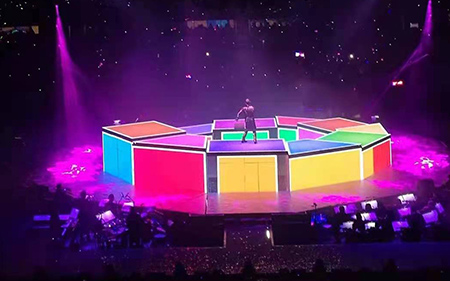Dust, these seemingly insignificant tiny particles, have an impact on LED rental screens that cannot be ignored. LED rental screens, as an important display tool in modern advertising and performances, require clarity and stability. However, dust, these seemingly insignificant tiny particles, can have a significant impact on LED rental screens. So, do you know what impact dust can have on LED rental screens? Let's introduce it to you:

Despite their small size, dust particles can block some of the pixels on the screen, causing the image to appear blurred and unclear. This not only reduces the visual experience of the audience but also affects the effectiveness of advertisements.
The brightness of the LED rental screens is output through reflection and lenses. If dust accumulates on the optical components, the reflectivity and transmittance will decrease over time, leading to a reduction in brightness.
Contrast is defined as the maximum brightness value that the LED rental screen display unit can output divided by the darkest brightness value. When in dark scenes, dust on the optical components can reflect stray light, projecting light that should not be emitted from the lens, increasing the brightness of the dark parts. Similarly, in bright parts, some light can be obstructed by dust, reducing the amount of light reflected and transmitted, and thus decreasing the brightness of the bright parts. This naturally results in a decrease in contrast.
When dust accumulates to a certain extent on the internal optical components of the LED rental screen, it can change the path of light, preventing light from converging at the same focal point, thus causing the images displayed on the screen to become blurry and unclear. We often think that dust only affects the appearance of the LED rental screen, but it also has such a big impact on the function of the screen. In daily life, it is necessary to pay attention to dust prevention to extend the lifespan of the product.
Since LED rental screens contain many delicate glass components and electrical components, their screens are very fragile and have a poor resistance to impact. Once subjected to a strong impact, the screen and other related components may be damaged. Also, do not apply pressure to the surface of the LED rental screen, such as pointing to a part of the screen with your finger.
The interior design of LED rental screens is very precise. If the environment is humid, it can easily lead to oxidation and corrosion, causing short circuits and other problems, leading to significant financial loss. Therefore, it is necessary to maintain a dry environment for LED rental screens. If moisture is found on the screen surface, gently wipe it off with a soft cloth before turning on the power. If moisture has entered inside the LED rental screen, it must be placed in a well-ventilated or warm place to evaporate the moisture. If the situation is more severe, professional help should be sought.
Cleaning the LED rental screen should be done with soft, non-fibrous material such as degreasing cotton, lens paper, or a soft cloth, lightly dampened with a bit of glass cleaner, to gently remove dust or dirt on the screen. When cleaning, do not use organic chemical solvents like alcohol or rough cloth or paper products, as these materials can easily cause scratches, affecting the display effect.
Long periods of overloading work can easily cause some pixels of the LED rental screens to overheat, and if it exceeds the limit, it can lead to permanent damage. The pixels of LED rental screens are made up of liquid crystals. When working at full load for more than 95 hours continuously, it will accelerate the aging process of the LED rental screen, and in more severe cases, burn out. Therefore, users should pay attention to usage time when using LED rental screens to avoid long hours of work. This not only can extend the lifespan of the LED rental screen and delay the aging process but also can prevent hardware damage.
In summary, we can see that in order to ensure the normal operation and extend the lifespan of LED rental screens, we must pay attention to the impact of dust on them. Only by doing so can we ensure that LED rental screens continue to provide us with clear, bright images, bringing a pleasant viewing experience to the audience.